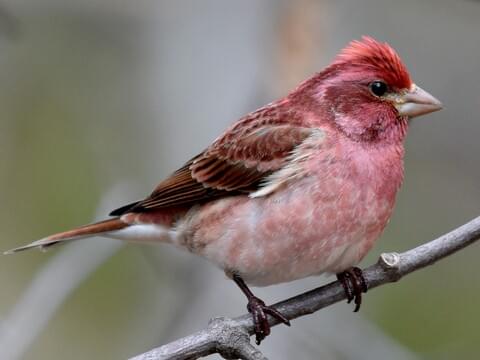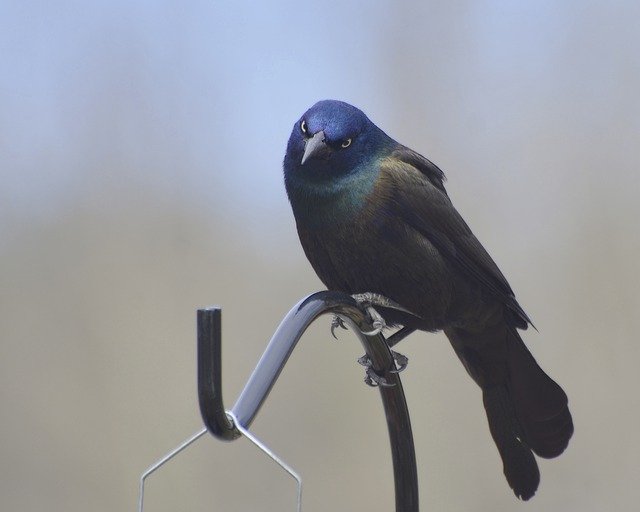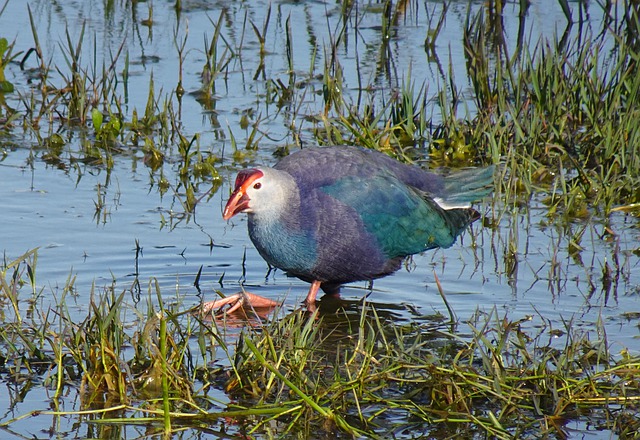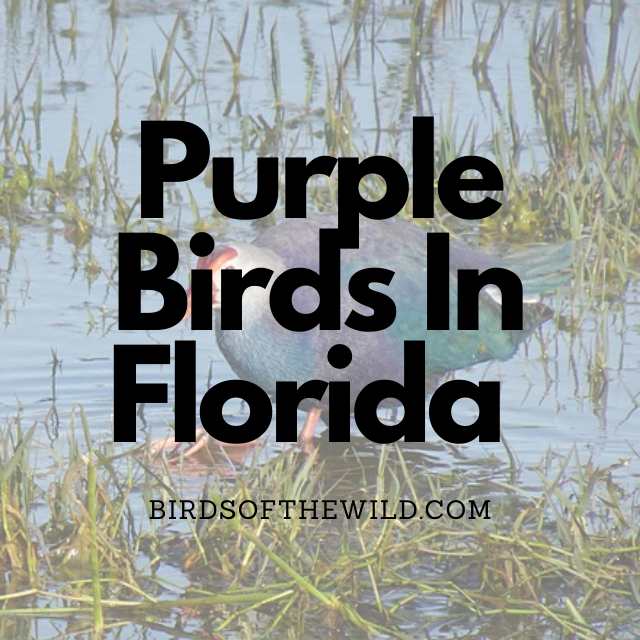Florida is home to a number of exotic birds, mammals and even the odd few dangerous critters so, it only makes sense that it would also be home to a number uniquely colored birds too. So, if you’ve found yourself here, it’s safe to assume you want to learn about this state’s purple birds right?
In that case you’ve found the right article because here I’ll be going over 5 unique purple birds that can be found in Florida.
- Purple Martin
- American Purple Gallinule
- Purple Finch
- Common Grackle
- Purple Swamphen
5 Purple Birds In Florida
1. Purple Martin (Progne Subis)

- Size: 19 – 20cm
- Weight: 45 – 60 grams
- Wingspan: 39 – 41cm
You can find these purple birds in Florida when throughout their breeding period. Breeding season for purple martins begins around late April – May and tends to end around late August – September.
Purple Martins are recognised by their almost entirely purple plumage with the wings and lower half of their body purple , with the remainder a darker blue color. Females on the other hand are mostly white and gray with hints of blue on their plumage.
As for where these birds live, it tends to be around open locations that are at least 40 ft. from trees or building so, you’ll often see them perching on utility wires and houses throughout their local neighbourhood.
Purple Martins consume mostly flying insects like house flies, crane flies, beetles, and even dragonflies. Dragonflies in particular are a very important part of their diet.
These avians have been known to live for 13 years but, the average for most probably wouldn’t surpass 6 – 7 years.
2. American Purple Gallinule (Porphyrio Martinicus)

- Size: 33 – 37cm
- Weight: 203 – 291 grams
- Wingspan: 55 – 56cm
American purple gallinules can be found in Florida year round as it is a permanent residence of theirs within the country.
Purple gallinules are recognised by their purple neck and chest, their green wings, their dirty yellow colored back, yellow legs and striking red beak. Females on the other hand are a dull brown color.
These purple birds tend to inhabit mostly freshwater marshes that hold water year-round and have sedges, grasses or rushes. Purple gallinules especially prefer areas with dense stands of emergent floating vegetation like the American lotus, water shield, spatterdock, pickerel weed, arrowhead, water pennywort, etc.
As for what their diet consists of, it includes feeding on spiders, mollusks, beetles, bees, worms, snails, dragonflies, leeches, moth larvae as well as frogs, small fish, eggs and nestlings of other birds.
Purple gallinules are known to live for around 22 years in most cases but, some have lived upwards of 25 years old.
3. Purple Finch (Haemorhous Purpureus)

- Size: 15 – 16cm
- Weight: 24 – 26 grams
- Wingspan: 25 – 26cm
You can find these finches in northern Florida when they aren’t breeding, which will often be around the fall and winter time. This is because they will breed throughout summer and spring.
Purple finches are recognised by their pinkish plumage with hints of purple throughout, their mohawk like head feathers and gray beak. Females on the other hand are mostly brown.
These finches can be found in coniferous and mixed woods, both in forest interior and along edges. They also tend to breed near oak trees and streamsides.
Purple finches tend to eat a variety foods from insects, small fruits, berries and seeds, with seeds being their go to food source.
The average lifespan for these birds is around 3 – 4 years, though many are also able to live till 6 or 7 years of age.
4. Common Grackle (Quiscalus Quiscula)

- Size: 28 – 34cm
- Weight: 74 – 142 grams
- Wingspan: 36 – 46cm
Common grackles can be found in Florida year round.
The common grackle is recognised by their purple head, brown mixed with hints of purple on their wings and back, blue wing tail and chest. Females are mostly a duller darker brown color with small inklings of purple on their body.
These birds tend to spend the majority of their time within wet, open woodlands and marshes as well as in suburbs, parks, and agricultural fields.
As for the type of food a common grackle eats, it includes eating many forms of crops like corn as well as nearly anything else that catches their eyes, which also encompasses the foraging of garbage.
The average lifespan for these birds is around 17 years whilst some are able to live till the age of 22.
5. Purple Swamphen Florida (Porphyrio Porphyrio)

- Size: 45 – 50cm
- Weight: 620 – 670 grams
- Wingspan: 90 – 100cm
You can find purple swamphen in Florida year round although, do keep in mind that it isn’t a native Floridian bird as it was actually introduced to Florida’s wilderness around 1996.
These birds have a are recognised by their wings which are a turquoise blue color, their belly, neck and upper head purple in color, along with their red beak/head and legs. Female purple swamphens look very similar to the males.
Purple swamphens can be found around Miami-Dade, Broward, Palm Beach and Hendry counties near a large variety of wetland areas like ponds, lakes, marshes, swamps, rivers and their floodplains, rice fields, and retention or water treatment ponds.
They tend to eat soft shoots of reeds and rushes along with small animals, such as frogs, snails, the eggs of other birds and ducklings.
Purple swamphens are known to live for around 22 years in the wild although the average number is likely a good bit lower.
If you want to check out some other birds from Florida whether red, orange or green click on each color to learn about them.
Amhil Khan, a dedicated nature enthusiast and the founder of BirdsOfTheWild.com, is a passionate advocate for the captivating world of avian wonders. With a deep-seated curiosity about the intricate lives of birds, Amhil’s journey began as a fascination and has evolved into a mission to inspire others to appreciate and protect these magnificent creatures.
Amhil’s love for birds led to the creation of Birds of the Wild, a platform where his expertise in ornithology, coupled with his captivating storytelling, provides readers with an immersive and educational experience. Through his lens and words, he captures the essence of birds in their natural habitats, offering a glimpse into their behaviors, migrations, and the ecosystems they inhabit.

